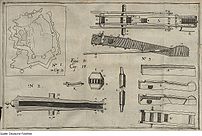- Kartouwe
-
Kartouwe exhibit in Königstein Fortress (Germany)Half-kartouwe exhibit in Magdeburg (Germany)
A kartouwe is a siege gun used in European warfare during the 16th and 17th centuries.[1] The name is a corruption of Latin quartana[2] (quarter cannon).[3] Kartouwe is of Dutch origin,[3] in the Holy Roman Empire the gun was called Kartaune in German or cartouwe in contemporary Latin,[4] in the Swedish Empire Kartow,[4] spelling variants include kartouw, kartouve,[5] cartow,[3] cartaun,[3] courtaun[3] and others.
Contents
Characteristics
Kartouwen were developed from bombards.[1] A kartouwe has a caliber of 8 inches (200 mm), weighs about 8,000 pounds (3,600 kg), and is designed to fire cannon balls weighing up to 52 pounds (24 kg).[6] As a minimum, twenty horses or oxen were needed to move a kartouwe.[6]
In addition to "whole" ("hele") kartouwen, there were also double,[7] half ("halve")[8] and quarter kartouwen.[4] The barrel of a whole kartouwen has a length of 18 to 19 times the caliber, weighs 300 kilograms (660 lb) to 350 kilograms (770 lb) and was transported on a special wagon by 20 to 24 horses, another four to eight horses were needed to transport the mount (lafette).[9] The barrel length of a half-kartouwen is 32 to 34 times the caliber, which ranges between 105 millimetres (4.1 in) and 115 millimetres (4.5 in).[9] Its barrel weighs 110 kilograms (240 lb) to 150 kilograms (330 lb), the whole gun 170 kilograms (370 lb) to 240 kilograms (530 lb).[9] Half-kartouwen fired cannon balls weighing between 8 pounds (3.6 kg) and 10 pounds (4.5 kg), and for the transport of its barrel, 10 to 16 horses were needed.[9]
Use and perception
Kartouwen were used for example in the Livonian War by the Russian[5] and Swedish forces.[7] During the Battle of Narva (1581), the besieging Swedish forces destroyed the walls of Narva, 5.5 metres (18 ft) strong, within two days using twenty-four double and half-kartouwen.[7]
Kartouwen were also the characteristic of the Thirty Years' War.[10] As such, they were featured in contemporary poems,[10] e.g. in Am liebsten bey der Liebsten by Sibylla Schwarz ("grausame Kartaune", "gruesome kartouwe").[11] In his 1844 poem Die Tendenz, Heinrich Heine used kartouwen to symbolize loudness.[12]
Sources
References
- ^ a b Meyers (1907), p. 682; Brockhaus (1911), p. 943
- ^ Meyers (1907), p. 682; Brockhaus (1911), p. 943; Adelung (1796), p. 1506
- ^ a b c d e Llewellyn (1936), p. 24
- ^ a b c Adelung (1796), p. 1506
- ^ a b Peterson (2007), p.95
- ^ a b Kasekamp (1990); Peterson (2007), p. 95
- ^ a b c Kasekamp (1990)
- ^ Kasekamp (1990); Adelung (1796), p. 1506
- ^ a b c d Medick & Winnige, entry "Stück"
- ^ a b Hartung (1995), p. 329
- ^ Sibylla Schwarz, Am liebsten bey der Liebsten: "So schreckt mich die Posaune / das Spiel der Schwerdter nicht / die grausame Kartaune / kompt nie mir ins Gesicht."
- ^ Sørensen & Arndal (2002), p. 23
Bibliography
- Hartung, Harald (1995) (in German). Gedichte und Interpretationen. Vom Naturalismus bis zur Jahrhundertmitte. Reclam Universal-Bibliothek. 7894. Reclam. ISBN 3150078946.
- Kasekamp, Andreas (1990). "Characteristics of warfare in the times of Henry of Livonia and Balthasar Russow". LITUANUS. Lithuanian Quarterly Journal of Arts and Science 36 (1). ISSN 0024-5089. http://www.lituanus.org/1990_1/90_1_02.htm. Retrieved 7 March 2010.
- Llewellyn, E.C.. "The Influence of Low Dutch on the English Vocabulary. Oxford University Press, London 1936". De Digitale Bibliotheek voor de Nederlandse Letteren. http://www.dbnl.org/tekst/llew001infl01_01/llew001infl01_01_0004.php. Retrieved 7 March 2010.
- Medick, Hans; Winnige, Norbert. "Begriffsregister zum Selbstzeugnis des Hans Krafft" (in German). Thüringer Universitäts- und Landesbibliothek Jena. http://www.mdsz.thulb.uni-jena.de/anhang/begriff_krafft.php. Retrieved 8 March 2010.
- Peterson, Gary Dean (2007). Warrior kings of Sweden. The rise of an empire in the sixteenth and seventeenth centuries. McFarland. ISBN 0786428732.
- Sørensen, Bengt Algot; Arndal, Steffen (2002) (in German). Geschichte der deutschen Literatur. 2 (2 ed.). C.H.Beck. ISBN 3406475892.
- "Meyers Großes Konversations-Lexikon, Band 10. Leipzig 1907, S. 682" (in German). zeno.org. http://www.zeno.org/Meyers-1905/A/Kartaune. Retrieved 7 March 2010.
- "Brockhaus' Kleines Konversations-Lexikon, fünfte Auflage, Band 1. Leipzig 1911, S. 943" (in German). zeno.org. http://www.zeno.org/Brockhaus-1911/A/Kartaune. Retrieved 7 March 2010.
- "Adelung, Grammatisch-kritisches Wörterbuch der Hochdeutschen Mundart, Band 2. Leipzig 1796, S. 1506" (in German). zeno.org. http://www.zeno.org/Adelung-1793/A/Kartaune,+die. Retrieved 7 March 2010.
Categories:- Siege artillery
Wikimedia Foundation. 2010.




